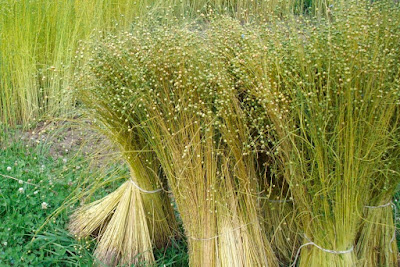The History of Food - LINHAÇA | LINSEED or FLAXSEED
A linhaça é a semente do linho (Linum usitatissimum), pertence a família Linaceae, é também muito utilizada na culinária. Em inglês é chamado de linseed ou flaxseed.
A linhaça tem cerca de 39% de óleo em sua composição. É preferível que se consuma sem casca, triturada, para melhor aproveitamento do seu alto valor nutritivo, pois é rica em fibras, ácidos graxos e proteínas. Além disso, dela se extrai o óleo de linhaça, que é rico em Ómega 3, Ómega 6 e Ómega 9.
Seu óleo é um dos alimentos mais ricos em Ômega 3 da natureza (cerca de 57%) e de Ômega 6. A relação ideal entre Ômega 3 e Ômega 6 é de 1:4 respectivamente, enquanto o óleo vegetal de linhaça apresenta uma relação de 1:3, muito próxima do ideal.
Devido ao seu alto valor nutritivo é considerado alimento funcional. No Brasil encontra-se duas variedades, marrom e dourada.
Outros usos do óleo de linhaça incluem a fabricação de linóleo e tintas a óleo. O óleo também é usado na indústria cosmética e em farmácias de manipulação.
Os relatos mais antigos da semente do linho são datados de 5000 anos antes de Cristo, na Mesopotâmia. Foram até encontrados desenhos da semente em tumbas faraónicas, o que comprova o uso desta herbácea desde a antiguidade.
Mesmo sendo originária da Ásia (Mesopotâmia), seus benefícios foram difundidos pelo mundo todo, se espalhou através da Europa, África e Américas. O consumo é muito comum na América do Norte e em países europeus.
Hoje, a linhaça é conhecida principalmente por apoiar a constipação, o controle do colesterol, o controle do diabetes e o trato digestivo, bem como por simplesmente aumentar a densidade de nutrientes de qualquer refeição.
Maiores produtores: Canadá (maior 40%), Estados Unidos, Índia e China. No Brasil, a produção é irrisória, restrita à região Sul.
* * *
Flaxseed is the seed of flax (Linum usitatissimum), belongs to the Linaceae family, is also widely used in cooking.
Flaxseed has about 39% oil in its composition. It is preferable to consume it without shell, crushed, for better use of its high nutritional value, as it is rich in fibers, fatty acids and proteins. In addition, linseed oil is extracted from it, which is rich in Omega 3, Omega 6 and Omega 9.
Its oil is one of nature's richest Omega 3 foods (about 57%) and Omega 6. The ideal ratio between Omega 3 and Omega 6 is 1: 4 respectively, while flaxseed vegetable oil has a ratio of 1: 3, very close to the ideal.
Due to its high nutritional value it is considered a functional food. In Brazil there are two varieties, brown and gold.
Other uses of linseed oil include the manufacture of linoleum and oil paints. The oil is also used in the cosmetic industry and in handling pharmacies.
The oldest reports of the flax seed are dated 5000 years before Christ, in Mesopotamia. Drawings of the seed were even found in pharaonic tombs, which proves the use of this herb since ancient times.
Even though it originated in Asia (Mesopotamia), its benefits were widespread throughout the world, spread across Europe, Africa and the Americas. Consumption is very common in North America and European countries.
Today, flaxseed is known primarily for supporting constipation, controlling cholesterol, controlling diabetes and the digestive tract, as well as simply increasing the nutrient density of any meal.
Largest producers: Canada (greater 40%), United States, India and China. In Brazil, production is negligible, restricted to the South region.
Planta da linhaça | linseed plant
Flores da linhaça | linseed flowers
Cápsulas verdes da linhaça | green flaxseed capsules
Colheita da linhaça | flaxseed harvest
Sementes de linhaça | Linseed
Instagram: @nutricleocoelho
Fontes | Search Sources:
- Wikipedia. Chia. Disponível em: <https://pt.wikipedia.org/wiki/Linha%C3%A7a>
- Terrapia. Linhaa. Disponível em: <https://www.terrapia.com.br/linhaa>
- Almanaque do Campo. Disponível em: <http://www.almanaquedocampo.com.br/verbete/exibir/73>
- Oficina de ERvas. Conheça a Linhaça e Seus Benefícios. Disponível em: <https://www.oficinadeervas.com.br/conteudo/conheca-a-linhaca-e-seus-beneficios#:~:text=O%20maior%20produtor%20do%20mundo,da%20%C3%81sia%2C%20possivelmente%20do%20C%C3%A1ucaso.>










Comentários
Postar um comentário